
The National Security Agency (NSA) is an intelligence agency of the United States Department of Defense, under the authority of the Director of National Intelligence (DNI). The NSA is responsible for global monitoring, collection, and processing of information and data for foreign intelligence and counterintelligence purposes, specializing in a discipline known as signals intelligence (SIGINT). The NSA is also tasked with the protection of U.S. communications networks and information systems. The NSA relies on a variety of measures to accomplish its mission, the majority of which are clandestine. The NSA has roughly 32,000 employees.

William Frederick Friedman was a US Army cryptographer who ran the research division of the Army's Signal Intelligence Service (SIS) in the 1930s, and parts of its follow-on services into the 1950s. In 1940, subordinates of his led by Frank Rowlett broke Japan's PURPLE cipher, thus disclosing Japanese diplomatic secrets before America's entrance into World War II.

The Communications Security Establishment, formerly called the Communications Security Establishment Canada (CSEC), is the Government of Canada's national cryptologic agency. It is responsible for foreign signals intelligence (SIGINT) and communications security (COMSEC), protecting federal government electronic information and communication networks, and is the technical authority for cyber security and information assurance.
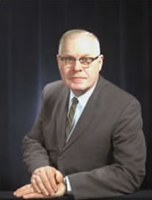
Frank Byron Rowlett was an American cryptologist.

Abraham Sinkov was a US cryptanalyst. An early employee of the U.S. Army's Signal Intelligence Service, he held several leadership positions during World War II, transitioning to the new National Security Agency after the war, where he became a deputy director. After retiring in 1962, he taught mathematics at Arizona State University.

David Kahn was an American historian, journalist, and writer. He wrote extensively on the history of cryptography and military intelligence.
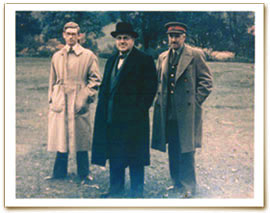
Brigadier John Hessell Tiltman, was a British Army officer who worked in intelligence, often at or with the Government Code and Cypher School (GC&CS) starting in the 1920s. His intelligence work was largely connected with cryptography, and he showed exceptional skill at cryptanalysis. His work in association with Bill Tutte on the cryptanalysis of the Lorenz cipher, the German teleprinter cipher, called "Tunny" at Bletchley Park, led to breakthroughs in attack methods on the code, without a computer. It was to exploit those methods, at extremely high speed with great reliability, that Colossus, the first digital programmable electronic computer, was designed and built.

The Central Security Service (CSS) is a combat support agency of the United States Department of Defense which was established in 1972 to integrate the National Security Agency (NSA) and the Service Cryptologic Components (SCC) of the United States Armed Forces in the field of signals intelligence, cryptology, and information assurance at the tactical level. In 2002, the CSS had approximately 25,000 uniformed members. It is part of the United States Intelligence Community.

The National Cryptologic Museum (NCM) is an American museum of cryptologic history that is affiliated with the National Security Agency (NSA). The first public museum in the U.S. Intelligence Community, NCM is located in the former Colony Seven Motel, just two blocks from the NSA headquarters at Fort George G. Meade in Maryland. The motel was purchased, creating a buffer zone between the high security main buildings of the NSA and an adjacent highway. The museum opened to the public on December 16, 1993, and now hosts about 50,000 visitors annually from all over the world.

William Bolding Black Jr. is a former Deputy Director of the National Security Agency.
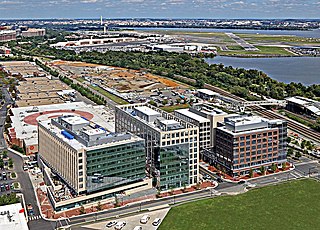
The Institute for Defense Analyses (IDA) is an American non-profit corporation that administers three federally funded research and development centers (FFRDCs) – the Systems and Analyses Center (SAC), the Science and Technology Policy Institute (STPI), and the Center for Communications and Computing (C&C) – to assist the United States government in addressing national security issues, particularly those requiring scientific and technical expertise. It is headquartered in Alexandria, Virginia.
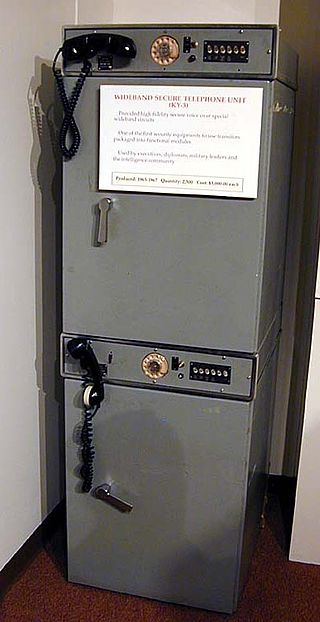
The KY-3 (TSEC/KY-3) is a secure telephone system developed by the U.S. National Security Agency in the early 1960s. It was one of the first widely accepted voice voice encryption systems. The "TSEC" prefix to the model number indicates NSA's Telecommunications Security nomenclature system.
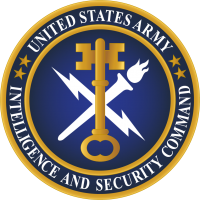
The United States Army Intelligence and Security Command (INSCOM) is a direct reporting unit that conducts intelligence, security, and information operations for United States Army commanders, partners in the Intelligence Community, and national decision-makers. INSCOM is headquartered at Fort Belvoir, Virginia.
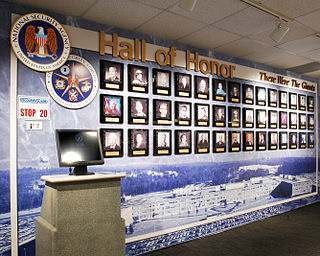
The Hall of Honor is a memorial at the National Security Agency headquarters in Fort Meade, Maryland. It honors individuals who rendered distinguished service to American cryptology.
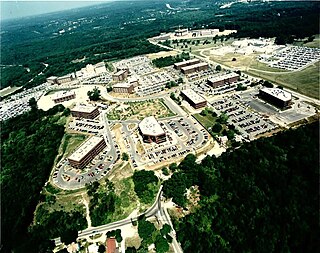
The Friendship Annex, also known as FANX or FANEX, is a National Security Agency (NSA) facility complex located in Linthicum, Maryland, near the Baltimore Washington International Airport (BWI). Established in the 1970s, the complex consists of multiple buildings and serves multiple roles as a cyber espionage station, electronic intelligence processing facility, and NSA Broadcast Network television studio. It is also the primary campus of the National Cryptologic School.
The United States' National Security Agency (NSA), an intelligence agency of the federal government, publishes many documents on the history and technology of cryptology, cryptography, and cryptanalysis through various publications.
Vint Hill Farms Station (VHFS) was a United States Army and National Security Agency (NSA) signals intelligence and electronic warfare facility located in Fauquier County, Virginia, near Warrenton. VHFS was closed in 1997 and the land was sold off in 1999. Today the site hosts various engineering and technology companies, as well as two Federal Aviation Administration (FAA) air traffic control facilities.
Brigadier General Bernard Ardisana was the assistant deputy director for operations at the National Security Agency at Fort George G. Meade. During his tenure with the US Military he also commanded the USAF Security Service's 6924th Security Squadron and went on to become the Vice Commander of the USAF Security Service. He died on January 14, 1978, from a heart attack at Kimbrough Army Hospital at Ft. Meade.
The Georgia Cryptologic Center (GCC) or NSA Georgia is a U.S. National Security Agency (NSA) and Central Security Service (CSS) facility located within Fort Eisenhower, located outside of Augusta, Georgia. The 604,000 sq ft (56,100 m2) facility opened on March 5, 2012, at a cost of $286 million. The GCC's facilities have the capacity to employ up to 4,000 personnel. Its primary focus is on signals intelligence intercepts from Europe, the Middle East, and North Africa. The facility is known by the codename "Sweet Tea".

Minnie M. Kenny was a cryptanalyst, educator and equal opportunity activist who worked at the National Security Agency (NSA). She served as deputy commandant at the National Cryptologic School and was responsible for creating scholarships for NSA employees. The recipient of numerous awards, including the Meritorious and the Exceptional Civilian Service Awards, the presidential Meritorious Executive Award and Distinguished Service Award of the CIA, Kenny was inducted into the Cryptologic Hall of Honor in 2009.
















